Surfer SEO Serp Analyzer – a tool you must know

Table of Contents
- Surfer SEO basic capabilities
- What is the titular data-driven?
- Data analysis in Surfer - where to start
- Surfer SERP Analyzer - how does it work?
- What data (ranking factors) does the Surfer Search Analyzer provide you with?
- Length of texts on the page
- Working with a graph of correlation coefficients
- Quick audit with Surfer
- Summary
Surfer SEO provides three tools of different utility.
Serp Analyzer
It is used for in-depth analysis of top 50 search results for the analysed phrase.
Content Editor
The editor will help us to create search engine-optimized content that will have a chance to rank high for selected keywords.
Keyword Research
The keyword research module, on the other hand, provides support in keyword analysis.
Surfer SEO basic capabilities
- Analysis of ranking factors for mobile and desktop versions;
- Exploration of many global markets, including for local enquiries;
- Assistance with content structuring;
- Support for link-building;
- Creating guidelines for copywriters;
- Keyword research.
This article will focus on the practical use of the Serp Analyzer tool. It is available only in the English language version, so I will discuss in detail its various functions in order to facilitate the use of the Surfer.
What is the titular data-driven?
Data-driven is a concept taken from the English language. It means an approach when a process or activity is compelled by data analysis and interpretation. In a data-driven organisation, decisions are based on data rather than feeling or intuition. More and more people are talking about data-driven marketing or data-driven organisation. The creators of the SFurfer have focused on data-driven SEO, providing a range of data to plan effective actions to increase visibility in organic Google search engine result pages (SERP).
Data analysis in Surfer - where to start
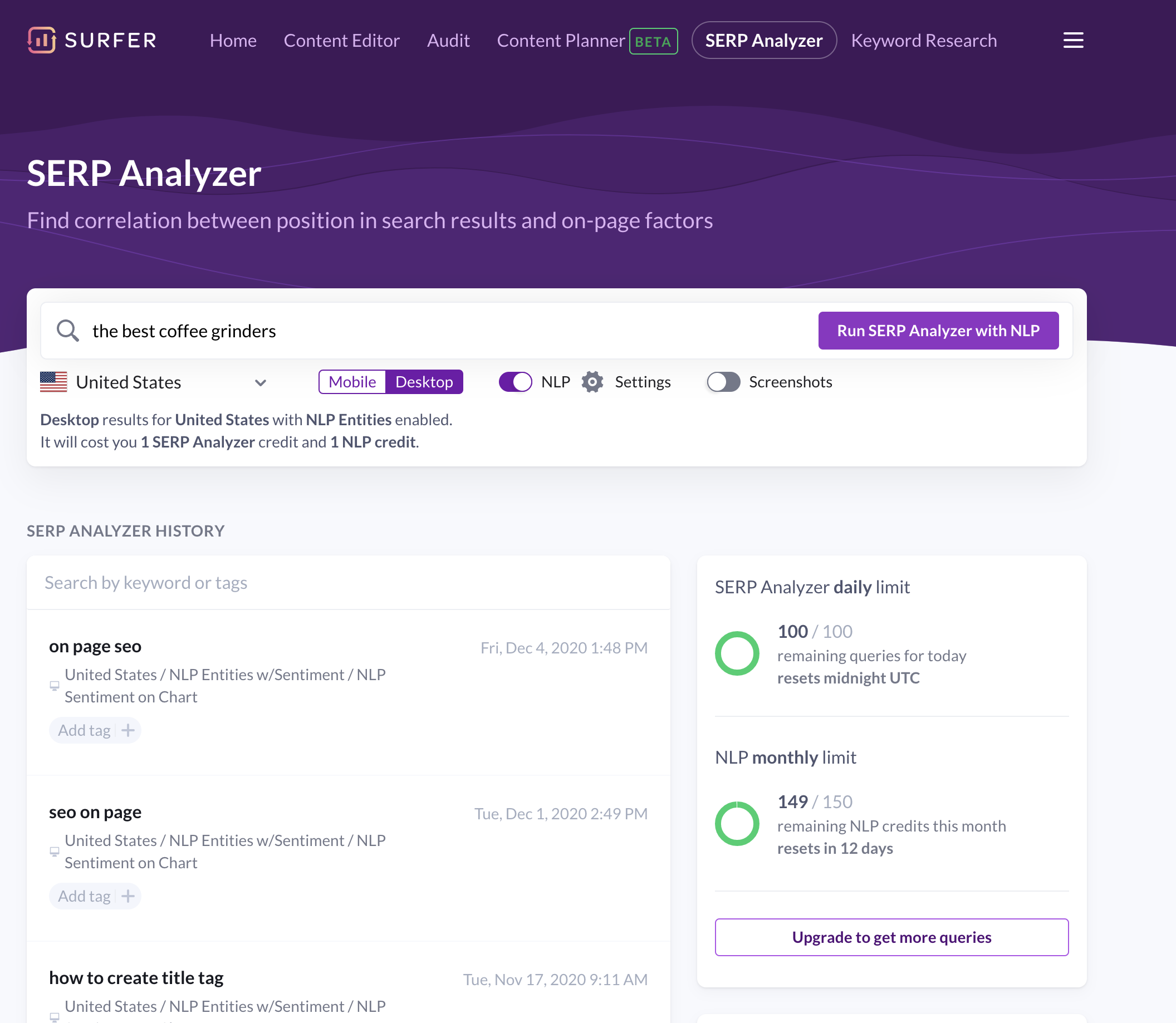
Surfer Serp Analyzer – the main interface.
Before you start working with the tool, you should set yourself a goal for your actions. For example, you can focus on analyzing the existing subpage in terms of the desired keyword phrase and planning actions to increase its visibility in the SERP.
The report must be configured at the beginning. After checking the Google Search Console for information on the source from which users are getting to us, you decide on which type of data to focus on - whether it is for mobile (mobile devices) or desktop (desktop devices). Even if traffic is obtained mainly from a single source, it is worth spending a few minutes and making even a quick comparative analysis.
Before the first report is generated, you also select the market or area that you wish to investigate. You have the opportunity to obtain information for many countries around the world. For selected markets, there are even regions or cities. It is possible to narrow down the results for 21 cities in Poland, which enables local data to be targeted. In the case of such queries, you can check the results for both the phrase " web positioning Warsaw" and the phrase "web positioning" with data concerning only the selected city.
 Surfer Serp Analyzer – preparing a query for the phrase "the best coffee grinders".
Surfer Serp Analyzer – preparing a query for the phrase "the best coffee grinders".
NLP is meant here (in a broad sense) as a natural language for analyzing users' moods. This feature is not available in some countries.
Selecting the Screenshots option will add graphics to the generated analysis that show how Google considers the website under consideration.
After selecting the options we are interested in, clicking create a query option will generate the desired data and your daily query limit will be reduced by one point.
Surfer SERP Analyzer - how does it work?
The tool analyses the first 50 Google search results for the selected keyword phrase. Ranking sites are examined for content and other factors important to Google. Correlations are indicated within each element, i.e. the effect on the ranking of sites in SERPs. In short, this is a report that will tell you what may be valuable for a particular keyword, considering Google ranking factors for that query, location and users' specific needs.
Creating a structure for good content is about analyzing as many factors as possible and matching them with the high-ranked competition. Having regard to the keywords (or other factors) found in the content of most top 10 ranking sites, you can improve the visibility of your site.
The whole analysis is based on the assumption that the results in the top 10 are considered to be of high quality, which the Google algorithm considers to be the most valuable for the user in a particular query. The aim is therefore not only to match the algorithm but also to respond to the user's needs. Once you set similar coefficients for your content, you become similar to the competition by informing Google that your website is equally valuable.
Both too high and too low a coefficient may have a negative impact on the website under examination. For example, a low density of keywords will make the website lack topicality for the phrase, while too high ones may be considered by the algorithm as an attempt to manipulate the Google ranking (spam).
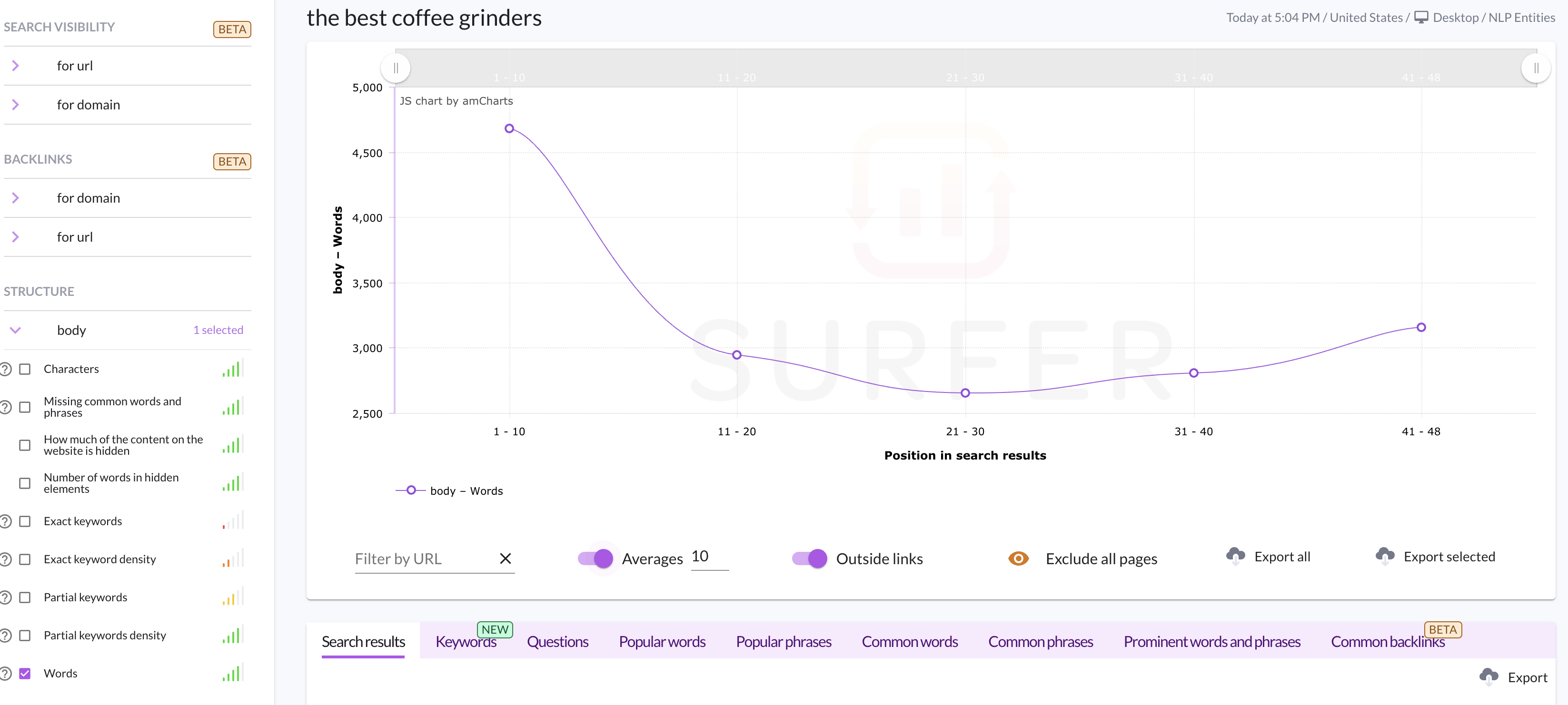
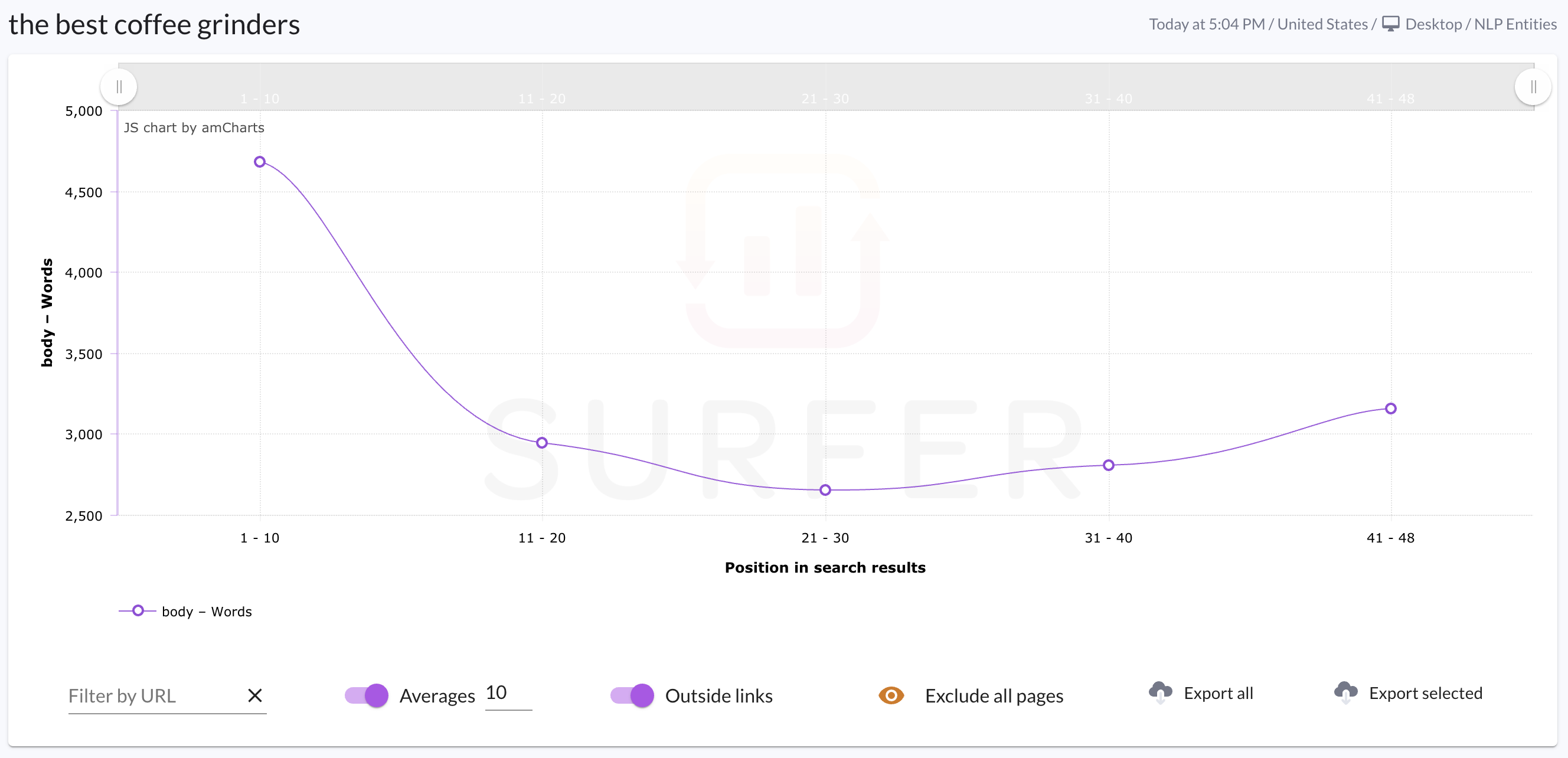
Surfer – coefficient from the body section – Exact keyword density for the phrase “the best coffee grinders”. A density of 0.013 can be considered unnatural as the more highly ranked sites have this coefficient at a level lower than 0.004.
Surfer assigns the ranking factors to segments, dividing them into logical categories. For each of them, a correlation coefficient is presented (a graph resembling the range icon in mobile phones) informing us about the influence of a given factor on organic search results for the examined phrase. By moving the cursor over its icon, you will check the exact percentage of the correlation. It changes depending on the range of data you are currently analyzing (e.g. when turning the view of individual URLs on or off).
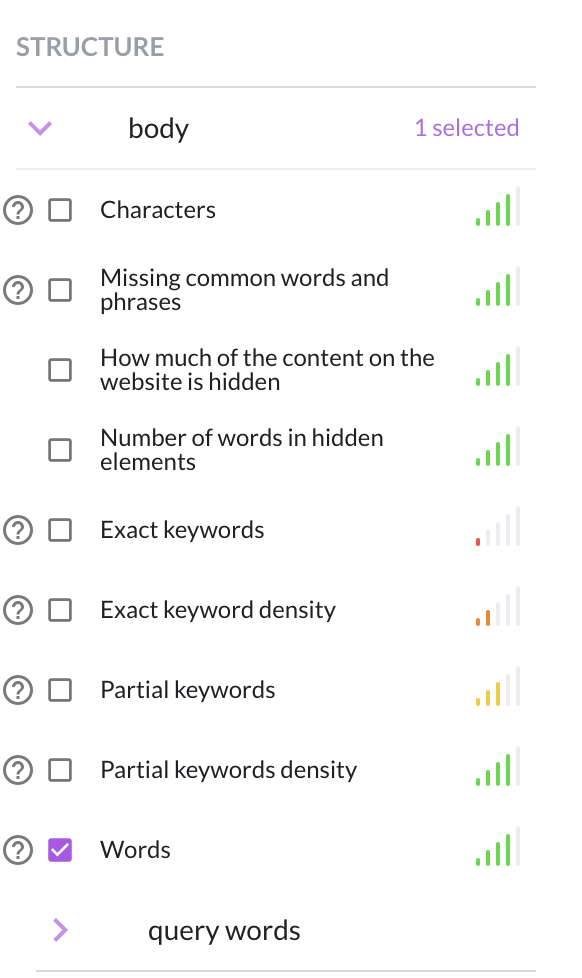
Correlation coefficients of the phrase "the best coffee grinders" for factors from the body section.
The correlation coefficient generated for each factor is obtained in the form of a clear graph on the right-hand side of the screen. It changes, as in the case of the correlation coefficient, depending on the range of data you examine. During the analysis, it is worthwhile to narrow the report down to the sites you are actually competing with in order to check what the actual correlation is like.
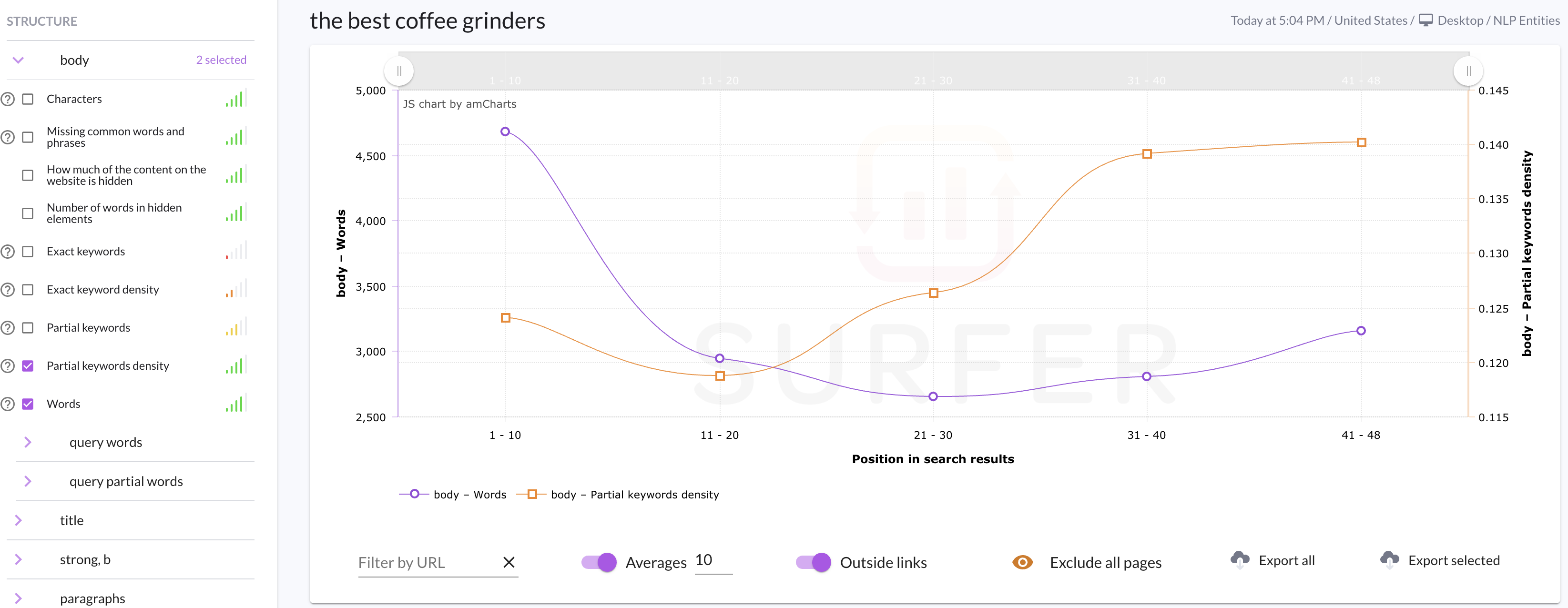
Correlation coefficients of the phrase “the best coffee grinders” for elements from the Body section - Partial keywords density, Characters and Partial keywords.
When analyzing the averaged data, it is worth excluding from the site view those sites which have the examined factor at an exceptionally high level in relation to other sites on similar positions. They may unnecessarily overestimate the value of the coefficient and disturb its average (the data will not be reliable then).
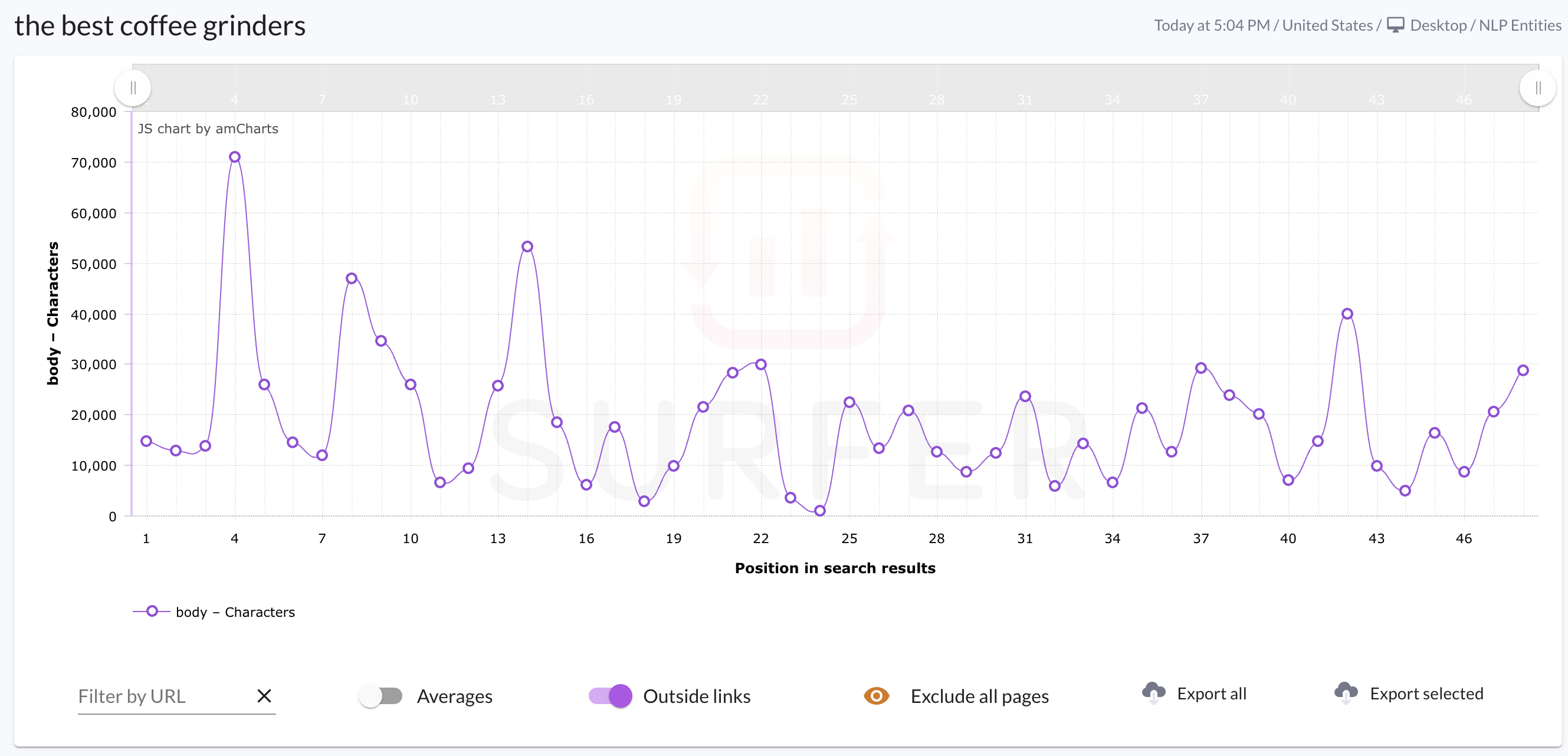
Three domains significantly overstate the average number of characters in the body for results in the range 11-22.
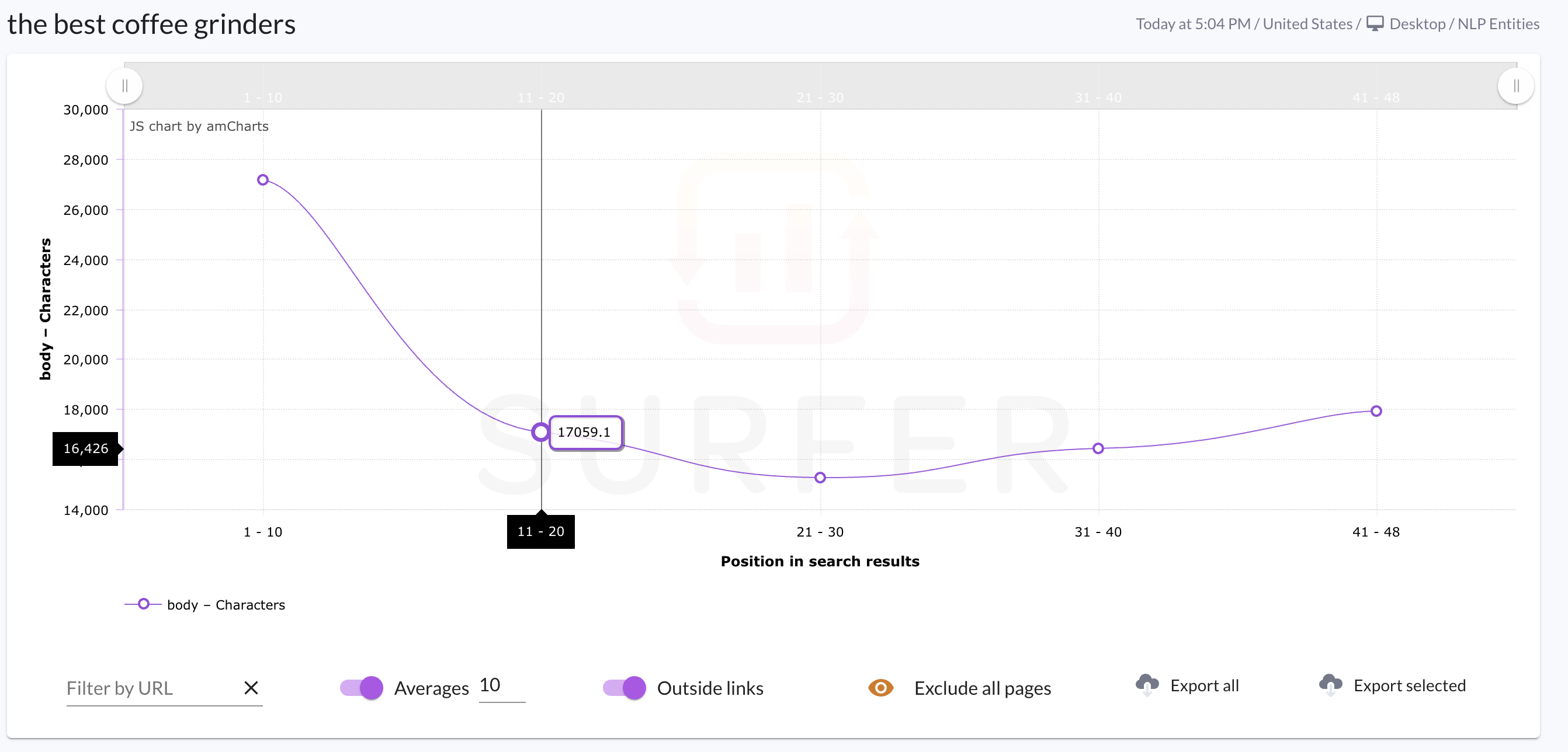
The average correlation coefficient for the top 50 phrases “the best coffee grinders”.
Correlation can also be distorted by websites that are not your direct competitors. Therefore, when performing the analysis, it is important to remember to check not only the website under investigation but also its surroundings. In such a situation, you mark on the graph the appropriate range of research results that you wish to analyse (e.g. from top 20 to top 50). Narrowing the data is also possible at the level of individual domains - you can turn off the view of those you do not wish to compete with. These are the sites that differ significantly from your site in terms of their subject matter, overstate the average and are not your direct competitors (e.g. Allegro, OLX or Ceneo). A particularly useful feature is the ability to directly compare coefficients for your site with one or more competing sites.
If your website is not included in the first fifty search results for a particular query, the Compare your website to competitors option comes in handy, allowing you to add any URL to your analysis.

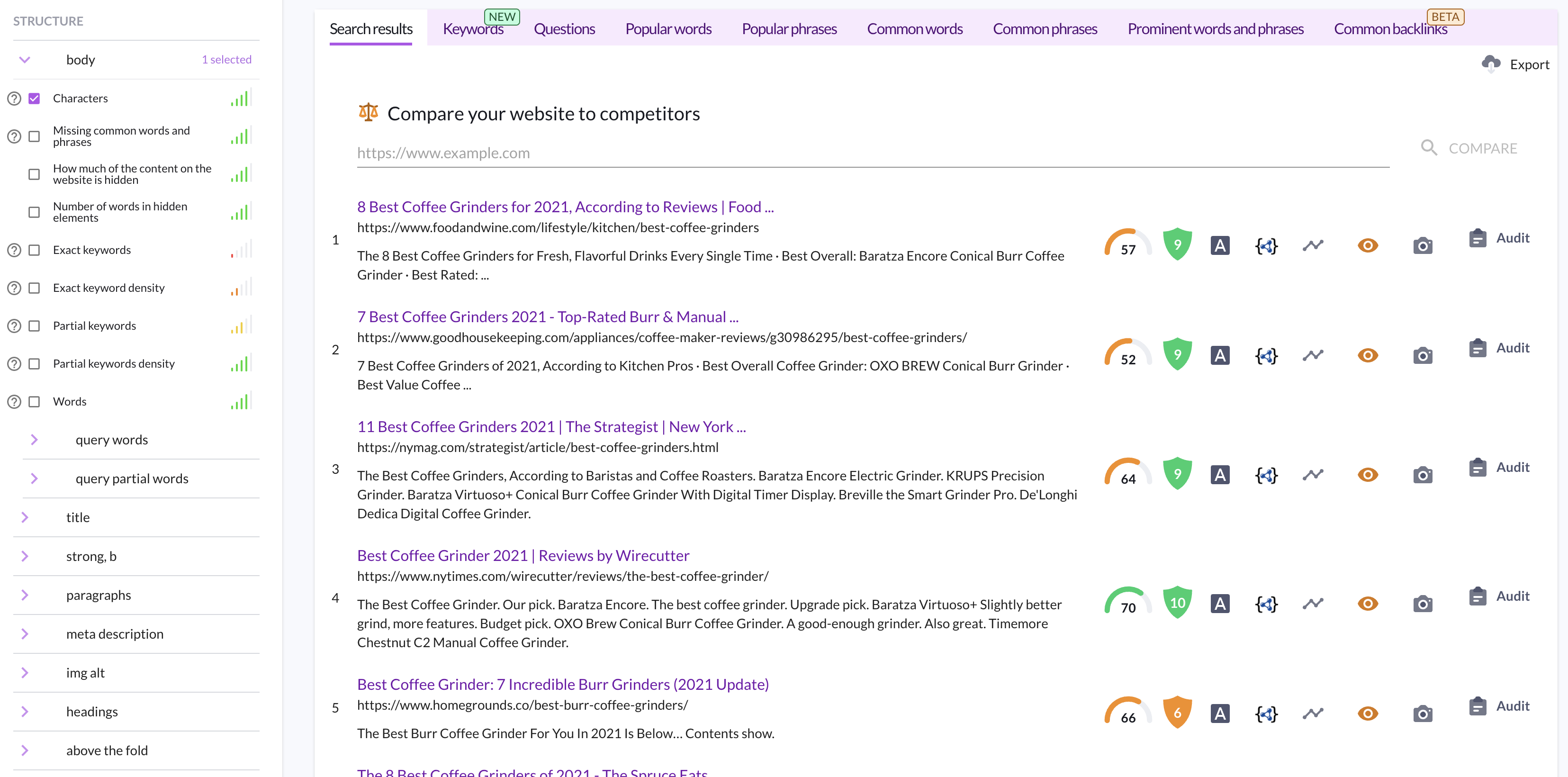
Surfer – Compare your website to competitors – a feature that allows a domain analysis that does not rank for the keyword under examination.
What data (ranking factors) does the Surfer Search Analyzer provide you with?
The tool examines coefficients for organic search results. Reports for Google Ads are not available. The analysis should be carried out comprehensively - the position usually does not depend only on the value of a single factor, it is necessary to consider all available coefficients. The data obtained is only a guideline for further analysis of the situation and taking appropriate action and help to compare the website to its direct competitors.
The Surfer Search Analyzer divides the examined coefficients into 5 sections: Search Visibility, Backlinks, Structure, Quality, and Media. The individual coefficients are accessed after opening the selected section.
Search Visibility – search visibility testing
Segment SEARCH VISIBILITY – visibility in organic Google search results. Surfer provides us with data for both the entire domain and for URL. You can examine for each of them the Number of ranked keywords - the number of phrases that are ranked and the estimated traffic, i.e. the estimated traffic in the examined domain (calculated on the basis of the number, type, and position of phrases that the domain or URL ranks for.
You can see on the graph the number of phrases under which the examined website and its competitors are visible for the top 100 results of the search engine and the volume of traffic estimated on the basis of the attractiveness of the phrase and the position of the website is ranked for.
For Domain – data for the whole domain.
You can use the estimated traffic and number of ranked keywords to see how the “strong” sites rank for the tested phrase. If we find only sites with high traffic and high visibility in SERP, this means that it will be very difficult or even unprofitable for you to gain a high position with a site with lower credibility. The presence of sites of comparable credibility gives a signal that there is a chance for a higher score in organic search results.
For URL – data for the ranking URL.
In this case, the number of ranked keywords ratio indicates the number of keywords under which a subpage is visible in search results. Estimated traffic is a measure of traffic generated by an entry. With low estimated traffic for a low-converting phrase (not for sale), creating very extensive content may prove uneconomic.
Backlinks – analysis of links
Segment BACKLINKS allows you to investigate the impact of links arriving at a domain or a ranking subpage on its position in organic Google search results. It should be remembered that the position of a website depends not only on its content but also on incoming links and user behavior on the website (behavioral coefficients). Surfer enables the basic analysis of backlinks for the analyzed URL and domain.
As with Search visibility, we check the coefficients for the main domain (for domain) as (!) (as well as) the address of the subpage under examination (for URL). Referring domains is the number of referring domains, Referring URLs indicate the number of all incoming links.
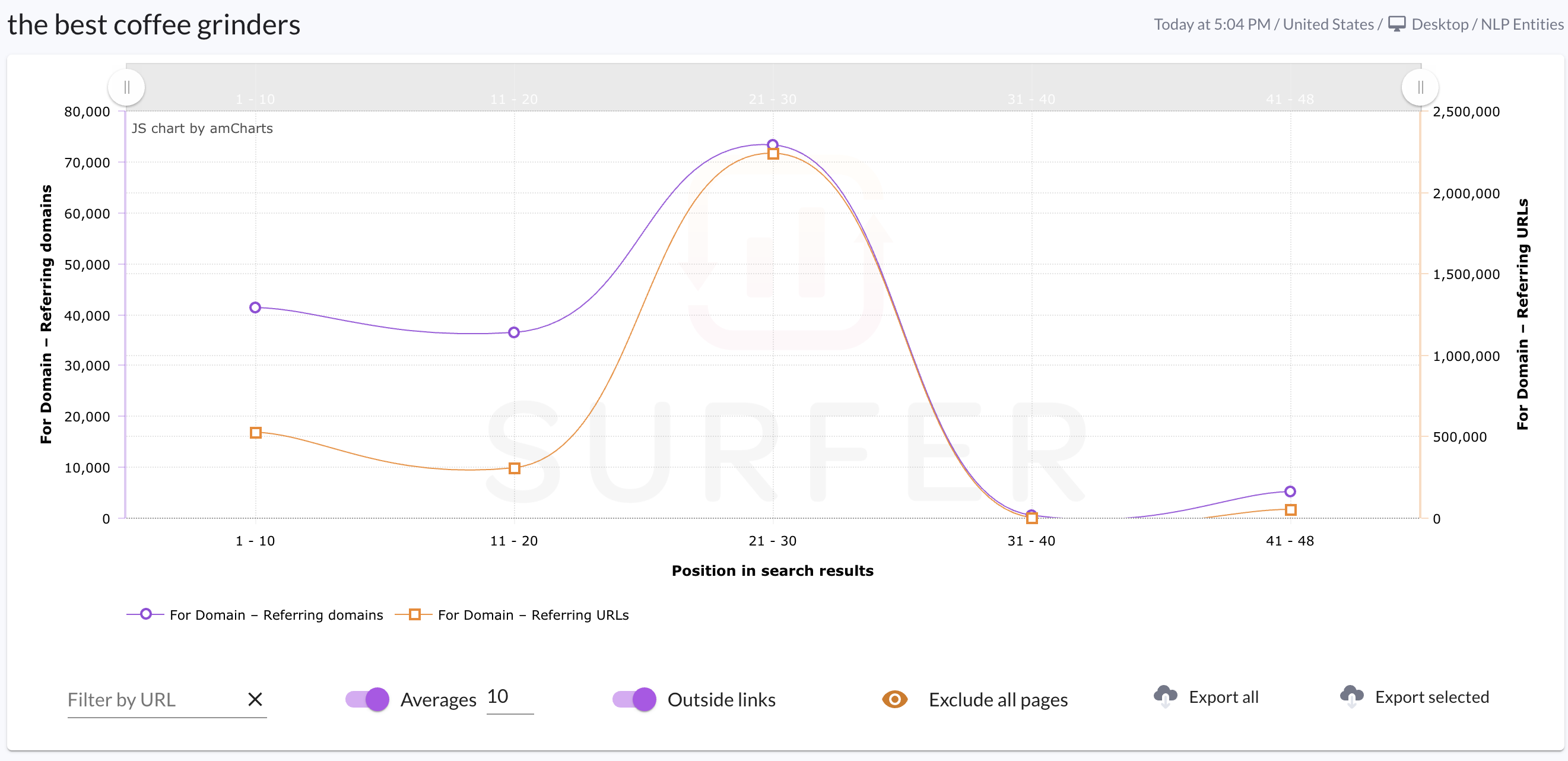
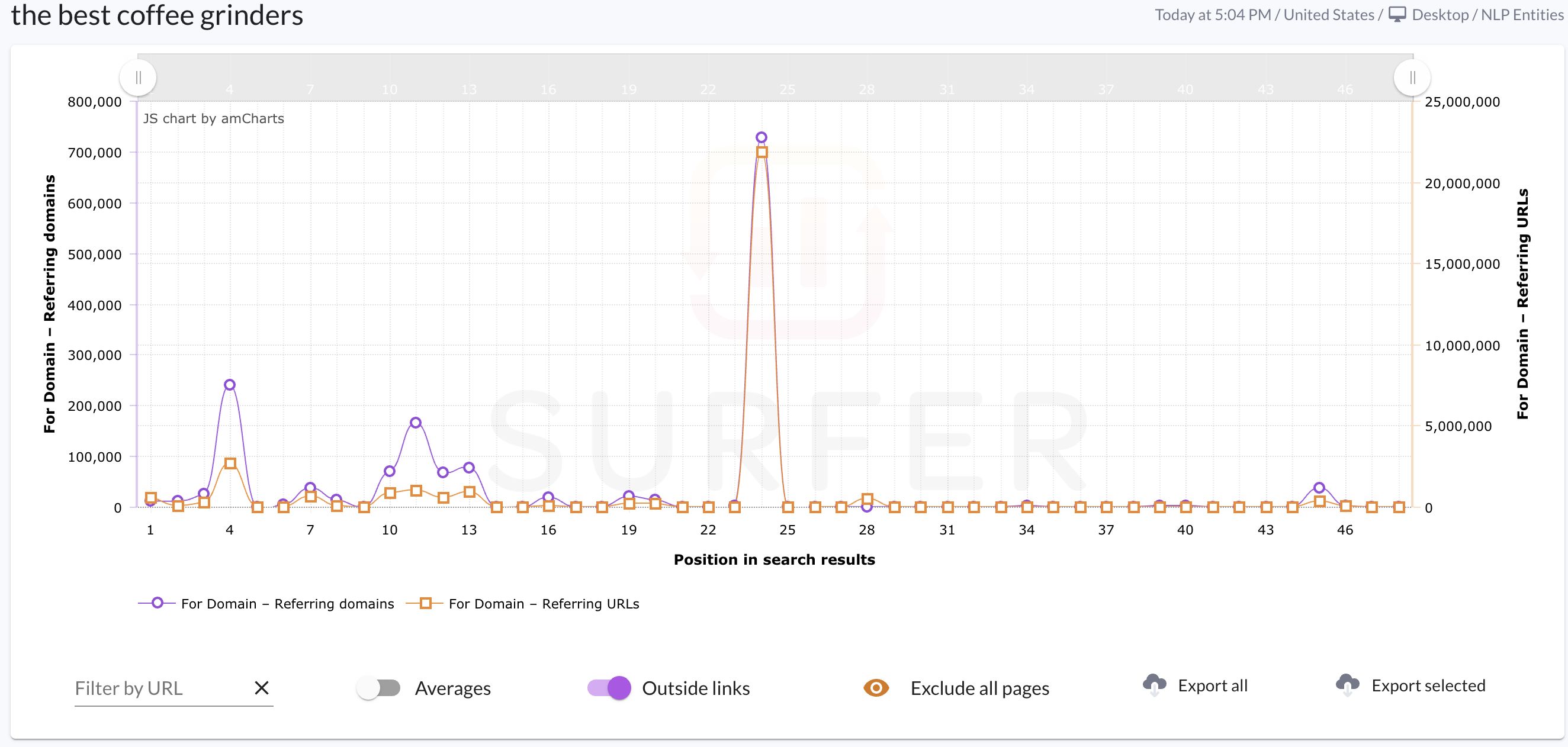
Surfer - coefficients from the Referring domains section for the main domain - phrase "the best coffee grinders". The number of links leading to a domain has some impact on the positions of this phrase, but is not the most important factor. The ideal example is Wikipedia, which, despite considerable trust (the number of links significantly exceeds the competition), is only on 32nd position.
Structure – data related to the structure of the ranking sites
Another segment of the Surfer Search Analyzer tool is STRUCTURE - coefficients related to the structure (construction) of the studied subpage, divided into several categories. We will examine similar elements for some of the coefficients from this section, so we will discuss them collectively.
Body – as the name suggests, there are elements contained in the body section of the analyzed subpage. This is the basic section from which you start your work, but you should not stop there. It is also worth focusing on the analysis of statistics for headlines and paragraphs, as well as factors related to the speed of loading the page.
Title – meta title tag analysis. The title of a subpage is one of the most important elements on site influencing the ranking in search results. Elements such as the occurrence of phrases in a strict or approximate match are particularly important here.
Strong, b – this is nothing more than content in bold font in the structure of the site. Too much bold for exact and partial words may mean an attempt to manipulate the ranking. Comparing the content of the competition is worthwhile to find the happy medium.
Paragraphs – this is where you find the statistics for the paragraphs into which the content is divided. Although this coefficient may seem trivial, it mentions a lot about the structure of the content developed by competitors. Certainly, the correct structure of the paragraphs affects the readability of the text for users (user friendly).
Meta description – one of the meta tags located in the source code of the website. It is currently not assigned any influence on the ranking of the website in SERPs, but it may have some influence on CTR. A well-built one has a better chance to encourage the user to visit your website.
Img alt – statistics on the use of the alt marker in the graphics in the entry. Adding phrases in the description of the images in a strict and approximate match may increase the topicality of your website and affect the display of images in Google Graphics.
Headings – analysis of ranking subpages based on the structure and construction of headings in the content. The presence of a keyword in the H1 heading is another element together with a title that you cannot omit. There are also lower grade headings, such as H2 and lower, which are important. Headings not only divide the content, allowing the user to quickly scan the article, but also have a significant impact on the topicality of the subpage and its ranking in search results. By clicking on the "A" icon next to each URL in the Search results tab, you can see which headlines your competitors have.
Above the fold – data concerning the content appearing in the first view of the page. By default, this is about 700 px. Here you will check whether placing key phrases high in the structure of the subpage is important for the ranking of the search engine in case of the phrase you are interested in.
Hidden content – examines elements that are hidden in the source code of the page in CSS styles through the "hidden" attribute and are not visible to the user.
The following data can be examined for most of the above-mentioned factors from the Structure section:
• Characters – indicates the number of characters in the component under examination.
• Missing common words and phrases – examine keywords and phrases that are common to top 10 sites. They can also be found on the Common words bar (common keywords). The coefficient enables you to catch the so-called content gap, i.e. missing elements in your content. Here we will find information about how the analyzed website fits into the subject matter of the examined phrase. When performing this research, you can exclude websites from the top 10, because this is the group of data on which the analysis for this coefficient is based. You check the frequency of keywords and where and in what density they should be used. To sum up, by performing an audit of a given site, you will obtain information on which phrases should be supplemented (added).
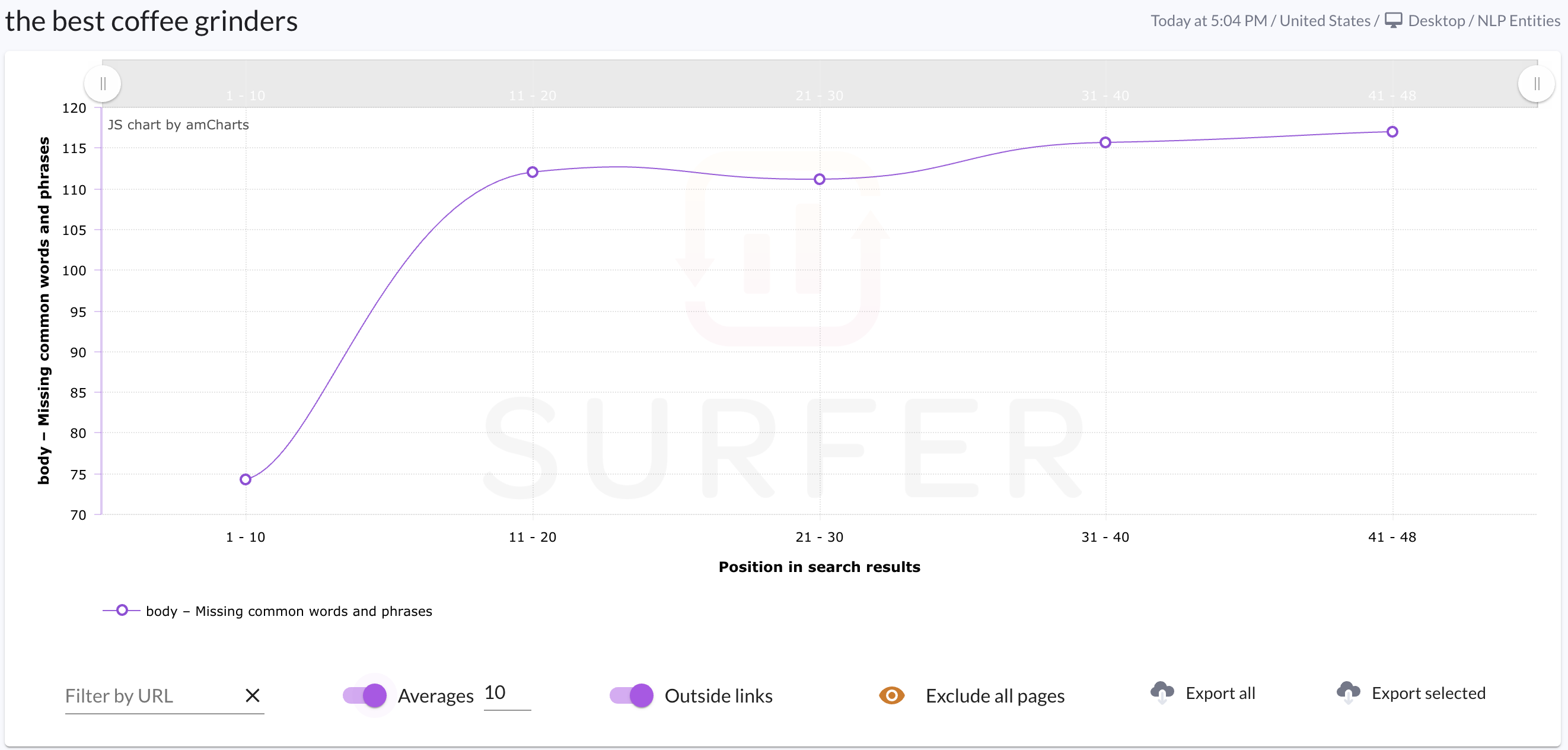
Surfer – correlation coefficient missing common words and phrases for "the best coffee grinders" - averaged view.
- How much of the content on the website is hidden – coefficient indicates how much content in the examined element is hidden in the page code.
- The number of words in hidden elements – indicates the number of words of hidden content.
- Exact keywords – this is the number of keywords in an exact match (in unchanged form).
- Exact keyword density – the density of the keywords in a close match with the rest of the content. As we explained above, both too much and too little keyword density in a close and approximate match can negatively affect the position in search results.
- Partial keywords –the number of frequency of phrases with an approximate match to the analyzed one. The Surfer analyzes the content of the site, searching for words whose first three characters are identical to the individual words in the key phase.
- Partial keywords density – the density of key phrases with the approximate fit.
- Words – statistics on the words contained in the content under consideration. You can download a detailed report from the Keywords tab to find out what keywords are ranking for the examined URLs. The Select competitors option allows you to set a range of data. Phrases can be sorted by volume (estimated monthly traffic) or by the number of pages in the examined ranking range per query. When determining the length of content, the key is the intention of the user to look for information. It cannot, therefore, be assumed that the optimum length of content is fixed for different queries.
Length of texts on the page
By examining how long a text ranking on the query should be, you will avoid writing too short a text that does not produce a good result and wasting a budget for a text that is too long and that does not affect visibility.
It may therefore seem a paradox to prepare for a Surfer tool a text as long as this one. After analyzing the number of words in the content ranking for the SurferSeo query, you see that material with less than 1800 words would be sufficient. This average is distorted by an entry on the 8th position with 5650 words. However, the purpose of this publication is not to raise the entries, but to provide a comprehensive overview that broadly describes the possibilities of the tool.
An analysis of Query Words and Query Partial Words is available for the above-mentioned correlation coefficients. The first one presents data for each word from the analyzed phrase, the second one examines words starting with their first three letters (similarly as in Partial keywords). The count tells you about the number and Ratio of the relation of the phrases examined to the rest of the content.
Tip:
How to quickly prepare guidelines for content using Surfer? Let's analyze the competition, taking into account:
-
length of the content,
-
structure of the contents:
- paragraphs,
- number and type of headings,
- words that should be included in the content (common words and common phrases),
- use of exact match (number),
- how many times you should use the individual words (query word count and ratio for each phrase), -
links – we use the backlinks section discussed earlier to study the links coming to the subpage and domain. Surfer also allows us to analyze in-depth internal and outgoing links. The following data is available:
- Dofollow – all the links with the dofollow parameter,
- External Dofollow – outgoing links with the dofollow parameter,
- External – all the outgoing links,
- Internal Dofollow – internal links with the dofollow parameter,
- Internal Nofollow- internal links with the nofollow parameter,
- Link Count – a number of all the links,
- Nofollow – all the links with the nofollow parameter,
- Sponsored link count – links with the sponsored parameter,
- UGC link count – links with the UGC parameter,
- Unique External – unique external links. This parameter tells us about the number of unique links coming out of the studied subpage. You can use this information to create a link-building strategy. On sites ranking on the phrase you are interested in and with a large number of outgoing links, you are very likely to be able to obtain a high-quality topical link.
- Unique Internal – unique internal links. The number of internal links allows you to determine what kind of website you are dealing with and check its internal structure. A large number of unique internal links may mean that the website under examination is an online shop or an extensive website that is not in direct competition and can be excluded from the correlation coefficient view. - URL – the last set of coefficients from the structure section, analyzing the elements contained in the URL.
- Exact keywords –the key phrase with an exact match. One of the most important elements repeatedly mentioned above. You examine it in most of the elements of the page structure, so it should not be omitted in the address of the ranking subpage.
- Partial keywords – phrases with an approximate match.
Quality – quality analysis of the ranking sites
The QUALITY section analyses the speed of the websites under study (Page speed) and the occurrence of so-called structured data in their source.
Page speed – the speed of loading the page is important for users (user experience) who are looking for specific information. The time that elapses from a click to the loading of content is important not only on mobile devices but also on fixed-line devices (desktop devices). If the content is loaded for too long, it can cause the user to leave the site quickly, which may reduce its Google ranking. The most common mistakes include placing large (heavy) graphic elements on the site and too many scripts that are activated when the site is opened. It is therefore worth checking:
- HTML size [B] – the size of the HTML code of the page in bytes,
- HTML size/character count – the size of the HTML code of the website in relation to the number of characters within it,
- Load time (ms) – loading time measured in milliseconds,
- Total page size [kB] – total page size measured in kilobytes. If it is too high, the page will load longer, which can be negatively perceived by users, especially those with poorer Internet connections,
- Total page size/character count – total page size divided by the number of characters,
- Time to first byte – (TTFB) measured in milliseconds, the time taken to load the first byte of data. The smaller the TTFB, the faster the page will load. Its average, optimal level is considered to be 300 ms.
Structured Data – are tags placed in the code of a website to describe and categorize elements on the website in a way that is understandable to Google algorithm. Surfer allows you to analyze the use of many popular tags, which have been sorted by their most commonly used types. Apart from checking data for each tag separately, you also have the possibility to determine the types of tags used. This information can be found by selecting Total structured data types.
The types of tags used are also visible in the search results tab, after moving the mouse over the icon indicating structured data.
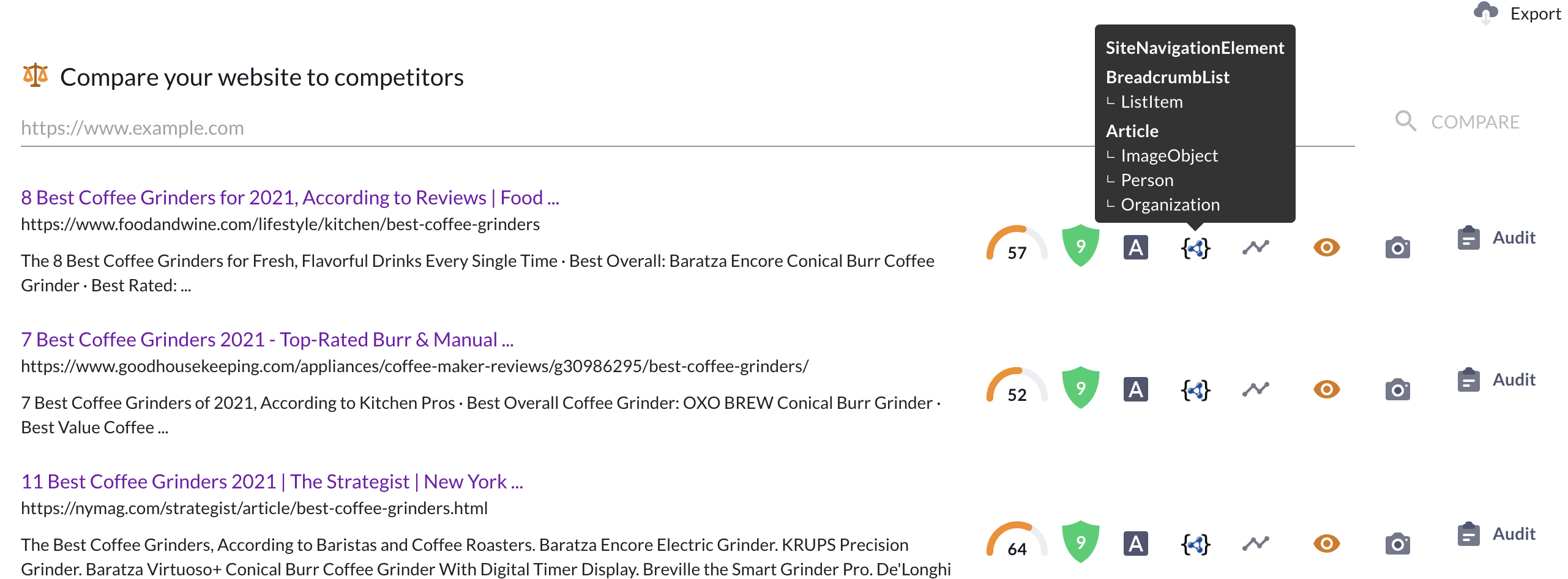
Surfer Serp Analyzer – structured data implemented on one of the ranking sites on a "best coffee grinders" request (one of the sites ranking for a query “dentist”).
Tip:
How to make quick changes to the website that (will) help improve its visibility (low-hanging fruit) with Surfer? Let's check the correctness and make the appropriate changes to the exact match phrase in the following elements:
- Title,
- H1,
- above the fold,
- body sites (of the site) (density - saturation of the phrase).
In the next step, let us improve the results for
- page speed,
- TTFB,
- Load time.
MEDIA – data related to the graphics contained in the ranking sites
In the last section of the Surfer coefficients – MEDIA – you can analyze the competition in terms of the number of images contained in the content. In this case, it is related to the type of query under consideration. If you are looking for information about girls' hairstyles, you will expect material with many graphics, unlike a person with a toothache who wishes to have contact details for the nearest dentist. The number of images on the page under review is given by the coefficient Number of elements.
Working with a graph of correlation coefficients
Adapting the graph to your analysis is very simple.
- Filter by URL - extracts in the Search results tab the URLs containing the character string indicated by us.
- Averages – presents two types of views. Averaged (collective analysis) allows observation of correlation, gives the average value for a group of pages. When deactivated, it presents data for individual sites. A single view can be used during comparative analysis with a specific page.
- Outside links – is an analysis only of the content that is not linked to other subpages of the site.
- Exclude all pages/Include all pages – allows you to disable or enable all the analyzed pages in the Search results tab. This option is useful when you wish to analyze only a few selected pages.
- Export all/Export selected – data download features for all/selected pages to CSV format.
Tip:
We can establish an average for a given factor based on several selected websites. If you wish to generate data for the first 6 results, you need to enable Averages and set its value to 6. In order to generate an average for random pages, using Exclude all pages you disable data inclusion for all pages, and then by clicking on the eye icon (Include URL in chart and audit), you include the examined URLs in the report and, as in the above example, you use Averages with a properly assigned value.
The tabs below the correlation graph allow generating aggregated data for the most important coefficients.

Surfer Serp Analyzer – tabs with details of the most important coefficients
Search results tab
Search results – contains sites with top 50 search results for the keyword phrase under consideration. Compare your website to competitors allows you to add an additional URL to your analysis. The icons next to each website address are defined in turn (as follows):
- Explore text of important elements – title, meta description, headings H1 – H6, bold phrases, and the hidden content of the site under examination,
- Structured data – structured data implemented in the page code,
- Show on a chart – a line in the chart, facilitating the comparison of the ratio of the examined page with the competition,
- Screenshot – graphic showing the view of the website read by the Google algorithm,
- Audit – Surfer audit containing information on relevant factors influencing the website position in search results.
Keywords tab
Keywords allow you to check which keywords rank for the pages of the top 50, their number, and the estimated organic traffic they achieve monthly from these keywords. You will also find the estimated monthly search volume for these phrases.
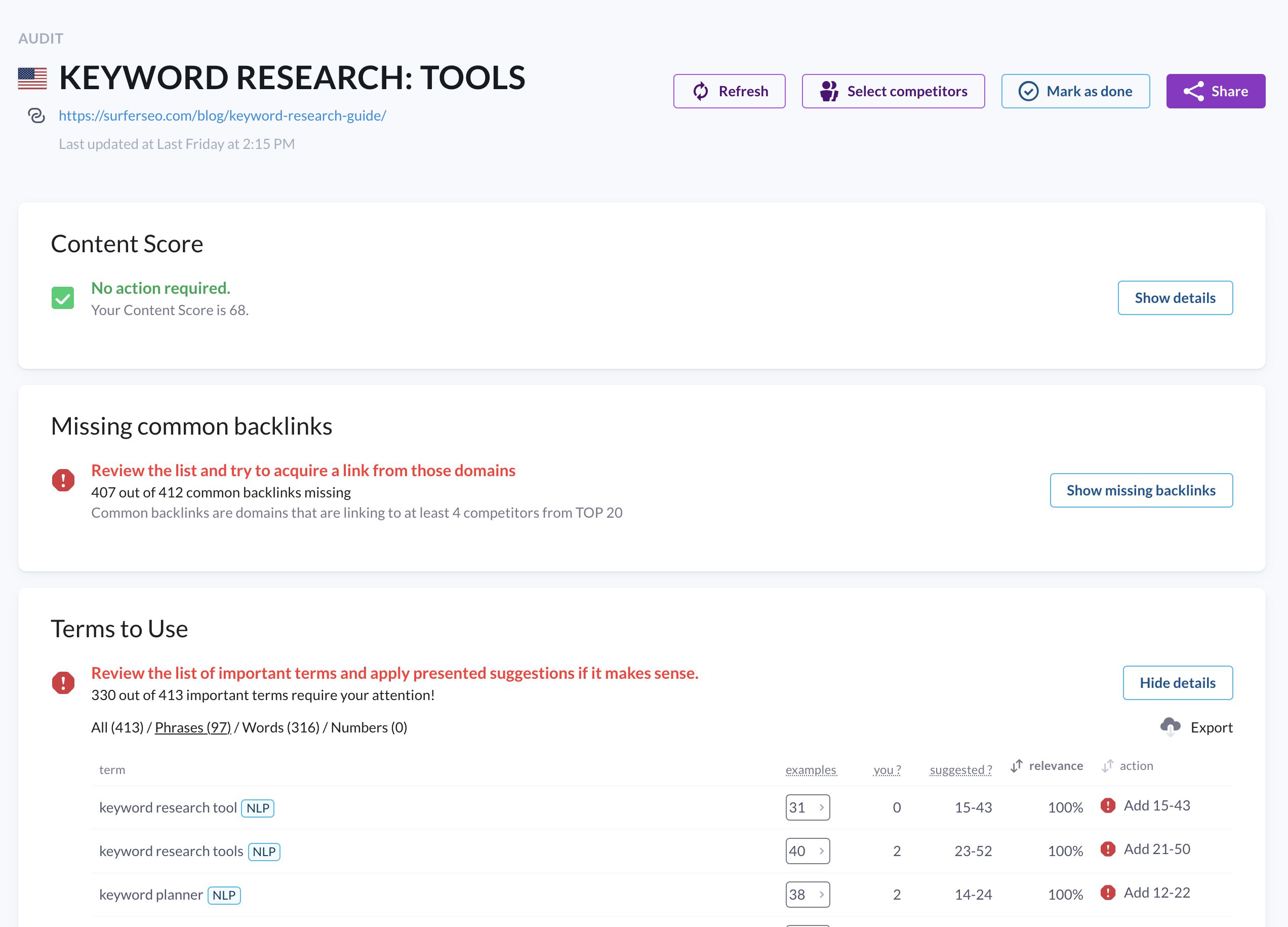
Surfer Serp Analyzer – Keyword reasearch tools
Popular words and Popular phrases Tabs
Popular words and Popular phrases – present keywords and phrases appearing on a given subpage with the highest frequency. This is an absolute value and the density of the word/phrase in relation to the whole content. They allow you to check whether the studied phrase is the main topic of the website or, for example, whether it is part of a larger study discussing the wider context.
Common words and Common phrases Tabs
Common words and Common phrases – you will find here words and phrases that are common to more analyzed sites in the top 10. (here you will find words and phrases that are common for a larger number of analyzed sites that are found in the top 10).
Prominent words and phrases Tab
Prominent words and phrases – words and phrases that appear more than once in at least two ranking websites in search results.
Common backlinks Tab
Common backlinks – a list of domains that link to the top 20 sites. You will find information on how many pages of (from) the top 20 search results are referred to and the URLs linking to them (the sites and linking URLs refer to).
Quick audit with Surfer
For each page, whether from organic results or a manually entered URL, you can generate a simplified audit that compares the analyzed page to the first 5 results. It presents data to help optimize the site. Noteworthy is the option of sharing the report with a colleague, client, or webmaster. Using the created link, it is possible to review the guidelines without the need to log in directly to the Surfer. In the audit, you will find coefficients analyzed by the Surfer with an indication of what changes should be made to get closer to the highest-ranked competition. Such an audit will be generated by clicking on the Audit button, visible at the analyzed websites in the tab Search results.
We will find information such as following in the report generated:

Surfer Serp Analyzer – a view of an audit linked to one of the ranking pages on the other subpage of the search results (a view of an audit available via the link for one of the ranking pages on the second subpage of the search results) for the phrase “payday loan”.
- Missing common backlinks – browsing the list of domains linking to competitors may tell us where to find the perfect place to add a link to our website. Surfer indicates how many pages of the top 20 search results have a link from a particular domain. Common incoming links can also be checked in the tab common backlinks.
- True density - this element indicates the expressions and words that may be relevant to the subject matter. We will find examples of the use of a phrase in the content, the number of times it appears on our website, and the suggested number of its occurrences. In determining the importance of the analyzed phrase, relevance (link to the topic) helps, indicating the percentage of its occurrence on pages with top 10 (on pages from the top 10). Phrases that are not anchors are not included in the keyword analysis.
The other groups of indicators are those already known to us in relation to the words on the page: Words, Exact keywords, Partial keywords, and data related to the number of different elements present in the structure of the website: Number of elements and Time to first byte and Load time (ms).
How to use this tool in practice? We search the Google Search Console for phrases with a large number of displays that rank in positions 8-15 (sample range). We select those whose traffic translates directly into conversion and, on the basis of the generated audit and data for individual coefficients, we make appropriate changes on our website. Getting closer to the top five will improve our visibility in the Google ranking for the phrase that interests us.
Summary
Surfer Serp Analyzer is one of the tools made available by the Suffer, enabling on-page and off-page SEO activities based on a detailed analysis of ranking factors. The information collected by the tool enables working with hard data. We analyze the competition, which is already high for the query under examination, to find the answer (to the question:), which factors the algorithm takes into account when establishing the ranking.
For whom?
For people involved in broadly defined Internet marketing who are looking for guidelines on website optimization, link-building support, and preparing guidelines for copywriters within the framework of inbound marketing strategy.
How much does the Surfer cost?
The cheapest plan (Hobby) is from $24.2 per month for an annual subscription. You will pay $82.5, $165.6, or $541.7 per month for plans corresponding to (suitable for) more demanding users (SEO and SEM agencies), depending on the package you choose.

























